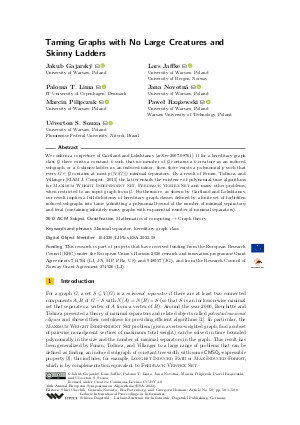Taming Graphs with No Large Creatures and Skinny Ladders
Authors
Jakub Gajarský  ,
Lars Jaffke
,
Lars Jaffke  ,
Paloma T. Lima
,
Paloma T. Lima  ,
Jana Novotná
,
Jana Novotná  ,
Marcin Pilipczuk
,
Marcin Pilipczuk  ,
Paweł Rzążewski
,
Paweł Rzążewski  ,
Uéverton S. Souza
,
Uéverton S. Souza 
-
Part of:
Volume:
30th Annual European Symposium on Algorithms (ESA 2022)
Part of: Series: Leibniz International Proceedings in Informatics (LIPIcs)
Part of: Conference: European Symposium on Algorithms (ESA) - License:
 Creative Commons Attribution 4.0 International license
Creative Commons Attribution 4.0 International license
- Publication Date: 2022-09-01
File

PDF
LIPIcs.ESA.2022.58.pdf
- Filesize: 1.25 MB
- 8 pages
Document Identifiers
Subject Classification
ACM Subject Classification
- Mathematics of computing → Graph theory
Keywords
- Minimal separator
- hereditary graph class
Metrics
- Access Statistics
-
Total Accesses (updated on a weekly basis)
0Document
0Metadata
Abstract
We confirm a conjecture of Gartland and Lokshtanov [arXiv:2007.08761]: if for a hereditary graph class 𝒢 there exists a constant k such that no member of 𝒢 contains a k-creature as an induced subgraph or a k-skinny-ladder as an induced minor, then there exists a polynomial p such that every G ∈ 𝒢 contains at most p(|V(G)|) minimal separators. By a result of Fomin, Todinca, and Villanger [SIAM J. Comput. 2015] the latter entails the existence of polynomial-time algorithms for Maximum Weight Independent Set, Feedback Vertex Set and many other problems, when restricted to an input graph from 𝒢. Furthermore, as shown by Gartland and Lokshtanov, our result implies a full dichotomy of hereditary graph classes defined by a finite set of forbidden induced subgraphs into tame (admitting a polynomial bound of the number of minimal separators) and feral (containing infinitely many graphs with exponential number of minimal separators).
Cite As Get BibTex
Jakub Gajarský, Lars Jaffke, Paloma T. Lima, Jana Novotná, Marcin Pilipczuk, Paweł Rzążewski, and Uéverton S. Souza. Taming Graphs with No Large Creatures and Skinny Ladders. In 30th Annual European Symposium on Algorithms (ESA 2022). Leibniz International Proceedings in Informatics (LIPIcs), Volume 244, pp. 58:1-58:8, Schloss Dagstuhl – Leibniz-Zentrum für Informatik (2022)
https://doi.org/10.4230/LIPIcs.ESA.2022.58
BibTex
@InProceedings{gajarsky_et_al:LIPIcs.ESA.2022.58,
author = {Gajarsk\'{y}, Jakub and Jaffke, Lars and Lima, Paloma T. and Novotn\'{a}, Jana and Pilipczuk, Marcin and Rz\k{a}\.{z}ewski, Pawe{\l} and Souza, U\'{e}verton S.},
title = {{Taming Graphs with No Large Creatures and Skinny Ladders}},
booktitle = {30th Annual European Symposium on Algorithms (ESA 2022)},
pages = {58:1--58:8},
series = {Leibniz International Proceedings in Informatics (LIPIcs)},
ISBN = {978-3-95977-247-1},
ISSN = {1868-8969},
year = {2022},
volume = {244},
editor = {Chechik, Shiri and Navarro, Gonzalo and Rotenberg, Eva and Herman, Grzegorz},
publisher = {Schloss Dagstuhl -- Leibniz-Zentrum f{\"u}r Informatik},
address = {Dagstuhl, Germany},
URL = {https://drops.dagstuhl.de/entities/document/10.4230/LIPIcs.ESA.2022.58},
URN = {urn:nbn:de:0030-drops-169969},
doi = {10.4230/LIPIcs.ESA.2022.58},
annote = {Keywords: Minimal separator, hereditary graph class}
}
Author Details
Funding
This research is part of projects that have received funding from the European Research Council (ERC) under the European Union’s Horizon 2020 research and innovation programme Grant Agreements 714704 (LJ, JN, MP, PRz, US) and 948057 (JG), and from the Research Council of Norway Grant Agreement 274526 (LJ).
References
- Tara Abrishami, Maria Chudnovsky, Cemil Dibek, Stéphan Thomassé, Nicolas Trotignon, and Kristina Vuškovič. Graphs with polynomially many minimal separators. J. Comb. Theory, Ser. B, 152:248-280, 2022. URL: https://doi.org/10.1016/j.jctb.2021.10.003.
- Vincent Bouchitté and Ioan Todinca. Treewidth and minimum fill-in: Grouping the minimal separators. SIAM J. Comput., 31(1):212-232, 2001. URL: https://doi.org/10.1137/S0097539799359683.
- Fedor V. Fomin, Ioan Todinca, and Yngve Villanger. Large induced subgraphs via triangulations and CMSO. SIAM J. Comput., 44(1):54-87, 2015. URL: https://doi.org/10.1137/140964801.
- Peter Gartland and Daniel Lokshtanov. Dominated minimal separators are tame (nearly all others are feral). CoRR, abs/2007.08761, 2020. URL: http://arxiv.org/abs/2007.08761.
- Martin Milanič and Nevena Pivač. Minimal separators in graph classes defined by small forbidden induced subgraphs. In Ignasi Sau and Dimitrios M. Thilikos, editors, Graph-Theoretic Concepts in Computer Science - 45th International Workshop, WG 2019, Vall de Núria, Spain, June 19-21, 2019, Revised Papers, volume 11789 of Lecture Notes in Computer Science, pages 379-391. Springer, 2019. URL: https://doi.org/10.1007/978-3-030-30786-8_29.
- Martin Milanič and Nevena Pivač. Polynomially bounding the number of minimal separators in graphs: Reductions, sufficient conditions, and a dichotomy theorem. Electron. J. Comb., 28(1):P1.41, 2021. URL: https://www.combinatorics.org/ojs/index.php/eljc/article/view/v28i1p41, URL: https://doi.org/10.37236/9428.
